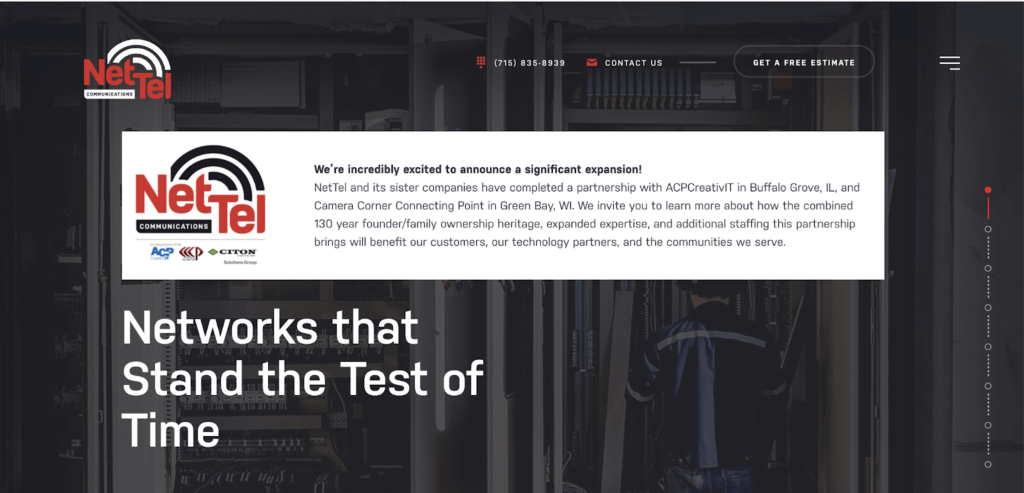If your company is going through an acquisition or merger, you’ll want to plan carefully what your website strategy will be – both in terms of communicating the business changes as well as understanding the SEO implications and opportunities – in order to maintain traffic, and align with the new brand direction.
It’s critical to put together a plan of action for the websites of both companies since they are one of the primary channels of communications and lead acquisition.
Before diving into the technical aspects of your website strategy, you must have a clear brand strategy so that the website(s) remain a reliable source of information during this time. A poorly managed transition can lead to confusion, loss of trust, and even significant drops in traffic and search engine rankings due to mismanagement of URL redirects.
“Marrying two entities, acquiring a new company, or dissolving an operation altogether requires a game plan, and a great deal of due diligence for success and to limit risk.”
– Erick Simpson, MSP Mastered (source)
Once you know whether you will merge the two websites or continue to manage two separate ones, you can then perform a website SEO technical analysis to provide insights on things such as redirects and content migration that must be handled to maintain the site’s authority and visibility in search engines.
In this guide, we will cover the key considerations that should be top of mind when managing website changes during an acquisition or merger.
1. Understand the Brand Strategy
Mergers and acquisitions can have varying impacts on the brands involved. It’s important to clearly define the branding approach to ensure consistency and alignment.
- Merger: Will both brands remain as they are, or will they merge into one? Define what this means for the existing sites.
- Acquisition: Is one brand being absorbed into the other? Plan a transition strategy accordingly.
- Rebrand/New Brand: If a new brand identity is being created, develop a checklist for creating the new logo, website, and other brand elements.
- Logos: A new logo may be required for any of the scenarios above. Evaluate whether a fresh identity is needed, and if so, ensure that visual elements are consistent across the site and other marketing materials.
2. Announce the Merger or Acquisition
First, being transparent is key. Use a section on your homepage or sticky bar to announce the merger or acquisition. You can even add a countdown to changes or a timeline of what to expect to make the transition smooth. You can use multiple communication channels to inform your audience about the changes.
- Website Banner: Add a website banner to notify visitors of the merger or acquisition. This banner should provide a quick summary of the changes and direct users to a dedicated page with more details. Ideally, the banner will point to a page with more info.
- Blog Article or Web Page: Add a page to your site that can act as a press release and which you can easily share via emails. MergerIntegration.com recommends including the following information:
- A title summarizing the merger or acquisition.
- Details about the companies involved and the terms of the agreement.
- Quotes from key executives expressing their vision and enthusiasm for the merger.
- Information on the strategic objectives and anticipated benefits of the merger.
- Any changes to company branding, leadership, or operations.
- Email Drip Campaign: Send a series of emails to let your customers know what is happening, when, and if/how it will affect them.
- Newsletter: Provide updates on what this change means for customers and what to expect in the coming weeks.
- Social Media Announcements: Post regularly to keep your audience in the loop.
3. What to Do About Marketing Campaigns?
How should your marketing campaigns be adjusted to reflect your M&A? Which strategies should you continue, stop, or overhaul? Addressing these concerns is important to maintain online visibility. Below are key considerations if your website is merging with or acquired another.
- Google Ads: Evaluate whether your ads campaign is aligned with the acquired or new website. It may be best to pause Google Ads temporarily to reassess targeting and keywords to reflect the target website. Depending on how different the service or products are on the new website, the campaign may need an overhaul.
- Link Building: Continue link-building efforts while prioritizing generating links to the new domain. Set up redirects from the old pages you previously targeted for link-building to relevant pages on the new website. This ensures the value of your previous link-building efforts is preserved and transferred effectively to the updated site.
- Google My Business (GMB): Ensure you update your GMB listing with the new name or merge locations if that applies. If you are still operating from the same location, it can be beneficial for you to update the listing name and keep the listing. This can help you appear in search more often since you’ll have listings in different areas.
- Blogging and High Traffic Pages: Ensure high-traffic pages are preserved during the migration process. For any blogs, product pages, or service pages that receive significant traffic and remain relevant after the merger, recreate them on the new site with the same or updated content. Implement 301 redirects from the old URLs to the new ones to maintain search rankings and provide a seamless user experience.
4. Best Practices for Redirects
Changing your domain or merging sites can significantly impact your SEO and user experience. To ensure a smooth transition, careful planning is important.
- Redirect Strategy: Set up 301 redirects from the old URLs to new URLs. This preserves the SEO value of existing pages and ensures that users find what they are looking for.
- Use Google’s Domain Change Tool: Use Google’s “Change of address” feature in Google Search Console to inform Google of the change. This helps ensure that Google is aware of the transition, reducing the risk of losing search visibility. To do this, go to Google Search Console > Settings > Change of address.
Summary
Understanding the brand strategy and addressing visual identity are crucial components to make the transition as seamless as possible when undergoing an acquisition or merger.
It’s also important to manage your MSP website to communicate changes effectively, ensure continuity for your audience, and preserve high-ranking content with proper redirects to maintain search engine visibility.
Key steps include announcing the changes prominently, carefully managing marketing campaigns, planning redirects, using Google’s domain change tools, and communicating updates through banners, emails, and social media.







